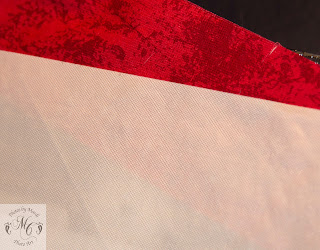My Lady dog is progressing. You can't see the plexiglass extension table set-up very well, but it holds it all together. A freezer paper pattern sits on the clear table. A silicone ironing sheet sits on top of the pattern and they are held on with office clamps. Tape will do the job as well. I can put a flattened Ott light under the table if I need to see the lines more clearly.
 |
| Set-up for fusing. |
Here is sweet Lady dog so far. The sharp edges of fabric will eventually be softened by quilting.
I lightly tack the fusible-backed fabric to the see-through ironing sheet, which lies over the paper pattern. When all the pieces are in place I will move the ironing sheet to the ironing board for a good, solid pressing. Then the dog will peel off the silicone in one big piece ready to iron onto a background. I might just incorporate background fabric while it is still on the ironing sheet. That works too.
Today I will explain how to get all those different pieces of fabric fused and cut with very little waste. I have a big stash, but still hate throwing anything into the wastebasket.

1. Cut the piece carefully from the freezer paper pattern. Set it aside.
TIP: These pieces are easy to lose. I often pin them to my pincushion so they can't fly away while I am fussing with fabric and fusable.

2. Cut a piece of fusible a bit bigger (1/4 inch or so) than the freezer paper pattern piece you just cut out. I usually cut a rectangle or circle...something quick and easy to cut. Both fusible (paper side up) and pattern piece are right side up.
3. Choose the area of fabric you want for this piece and fuse the fusible to the back. Leave the paper on for now.
 TIP
TIP: I use Soft Fuse, which has paper on only one side. If you use fusible with paper on both front and back, you will have to take the bottom piece of paper off to fuse to the fabric.
4. Cut from the back closely around the edges of the fusible. You leave the back paper on so you can see where to cut. This way you don't have any fabric with unseen fusible left on it.
TIP: Those clippers are fabulous. I got them in the gardening department of Home Depot. Not expensive. Super sharp. Super points.

5. With fusing side down lay the freezer paper pattern shiny side down on the fabric. Press to adhere and cut a about 1/16 inch larger than the paper pattern.
TIP: Do all the ironing on a silicone ironing sheet. That fusible stuff has a way a getting out and messing up your ironing cover.

6. Now you can pull the fusible paper and the pattern piece off. Your fabric piece is ready to tack to the silicone sheet in its proper place on the dog (or whatever creature you choose to make).
I end up with holes in fabric, but very little lands in the wastebasket and only a few small pieces are left with fusible on the back, which I use as I go along for the the tiny pieces that I need.
TIP: Save all your freezer paper pattern pieces in a container. Sometimes the fabric I choose doesn't look right and I need to pull it off and cut it again out of a different fabric. It is a three ring circus finding the right piece, but it is in there somewhere!
Sew some happy seams this week. I wish you a week of fabric immersion and contained fusible.



















